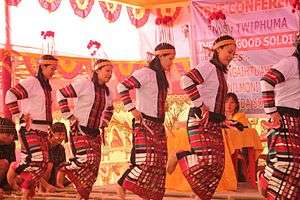Chapchar Kut
The Chapchar Kut is a festival of Mizoram, India.[1] It is celebrated during March after completion of their most arduous task of jhum operation i.e., jungle-clearing (clearing of the remnants of burning). It is a spring festival celebrated with great favour and gaiety.
| Chapchar Kut | |
|---|---|
| Observed by | Ethnic Mizo |
| Type | Mizo festival |
| Significance | Spring festival. 1 day long |
| Date | 2 March |
Origins and history
Chapchar Kut is estimated to have started in 1450–1700 A.D. in a village called Suaipui. The festival apparently originated when the hunters came back to the village empty handed, to make up for the disappointment, the Village chief proposed an impromptu feast with rice beer and meat. Since then, everyone the festival had been repeated by the village of Suaipui and spread on to other villages.[2] Chapchar Kut was first revived in 1962 on a grand scale in Aizawl, however it was discouraged when it was felt that it did not adhere to Christian values and rekindling the pre Christian cultural practices like drinking of rice beer, however, it was continued in 1973 on a mass scale sans animistic practice and cheraw dance.[3] Even the Church which had remined critical of the festival no longer objected to the festival as it felt that traditional culture was disappearing.[4] Chapchar Kut is now held annually in the Month of March. People dance, perform skits, play musical instruments to celebrate their beloved festival with the aims of bringing camaraderie among the people.[5]
Chapchar Kut is one of three annual festivals of the Mizos celebrated to mark three different stages of the agricultural cycle. The other two are Mim Kut and Pawl Kut, also revived in the last century.
Celebration
Oral traditions say Chapchar Kut was first celebrated in Seipui village in adjoining Myanmar that has a sizeable population of Mizos and their ethnic cousins. Chapchar Kut used to be celebrated to thank the gods for saving the people from harm during the clearing of forest on hill slopes for jhum cultivation at the beginning of a year. The festival used to be observed with a lot of drinking and eating. On the first night the young men and women would dance all night. The women would come dressed wearing a Vakiria. Chai dance has its origins in this festival.[6]

Today, the festival is observed in the last part of February or the early part of March when the trees and bamboos felled for jhum are left to dry and the shifting cultivators have time to relax and enjoy.[7]
The Main activities which are done during the Chapachar Kut are:
- Chhawnghnawh - A pre-Christian custom of stuffing a boiled eggs into each other's mouths.[8]
- Dance - Cheraw dance is the Main dance but other dances performed during the festival are Khuallam, Chheihlam, Chai and Sarlamkai[9]
- Arts, craft and Photo Exhibition.[10]
- Chapchar Kut run.[11]
- Mizo Traditional Games and costume parade.[12]
- Wearing of Traditional dress at work places.[13]
- Stalls with Etnnic cuisine.[14]
References
- Barthakur, Dilip Ranjan (2003). The Music And Musical Instruments Of North Eastern India. Mittal Publications. p. 55. ISBN 978-81-7099-881-5. Retrieved 8 August 2012.
- "THE ORIGIN OF THE CHAPCHAR KUT". mizoram.nic.in. Retrieved 12 March 2020.
- Thanzawna. "Origin of Chapchar Kut". Mizoram.nic.in. Retrieved 9 August 2012.
- Pachuau, Joy. The Camera as Witness. Cambridge. pp. 275–276. ISBN 9781107073395.
- "Chapchar Kut: The Festival of Bonhomie". thenortheasttoday. Retrieved 12 March 2020.
- LALTHANGLIANA, B. Culture and folklore of Mizoram. Retrieved 10 December 2018.
- Hindustan Times. "Egged on: Mizoram festival revives pre-Christian custom". Hindustan Times. Retrieved 8 March 2016.
- "Call to promote Mizo moral code and tradition". nenow. Retrieved 12 March 2020.
- "Mizoram celebrates its biggest festival 'Chapchar Kut'". eastmojo. Retrieved 12 March 2020.
- "Mizoram: Chapchar Kut celebration underway". morungexpress. Retrieved 12 March 2020.
- "Mizoram all set to celebrate Chapchar Kut on Feb 28 & March 1". eastmojo. Retrieved 12 March 2020.
- "Mizoram all set for Chapchar Kut festival". Telegraph India. Retrieved 12 March 2020.
- "Mizoram to celebrate Chapchar Kut on March 6". nenow. Retrieved 12 March 2020.
- "Chapchar Kut' festival celebrated with cultural fervour across Mizoram". Business standard. Retrieved 12 March 2020.